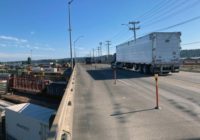After years of drafting and reviews, the Federal Highway Administration (FHWA) has issued a final rule that updates and revises its highway bridge inspection standards for the first time since 2009.
The new regulation, published in the Federal Register on May 6, was mandated by the 2012 Moving Ahead for Progress in the 21st Century Act (MAP-21).
A key focus in the MAP-21 provisions is a directive that FHWA use a “risk-based” approach in revising bridge inspection requirements and that approach is a theme in the agency's new standard.
In its Federal Register notice, FHWA said the risk-based approach “provides additional flexibility to bridge inspection organizations by applying their experience and engineering knowledge to determine the use of limited resources in a more optimal way across their inventory.”
Matt Reiffer, American Council of Engineering Cos. vice president of infrastructure programs, says, “This framework ensures qualified inspectors on every job, empowers the exercise of professional engineering judgment and provides the necessary flexibility for addressing the most pressing areas of concern and allocating limited resources.”
Reiffer said in emailed comments to ENR that many of ACEC's recommendations were included in MAP-21 and reflected in the final version of the FHWA standard.
Those recommendations include "rigorous professional licensing and training requirements for bridge inspectors and a risk-based, data-driven approach to inspection intervals," he said.
An important provision of the new standard centers on the required minimum interval between inspections.
In general, bridges now must be inspected every 24 months. State departments of transportation (DOTs) can seek FHWA approval for longer intervals than 24 months. The maximum is 48 months. Some bridges are subject to 12-month intervals.
Under the new standard, there are options for state DOTs and other inspection organizations allowing routine inspection intervals of up to 48 months and a maximum of 72 months for underwater inspections.
Two Options for Setting Inspection intervals
FHWA's new standard offers state DOTs two main options for interval-setting: Method 1, which the agency said in its published notice, uses "a simplified assessment of risk," and Method 2, which it says uses "a more rigorous assessment of risk."
Method 1 requires state DOTs to develop criteria to determine when inspections must be done more frequently than every 24 months because of factors such as a bridge's age, condition ratings, traffic level and loads.
Method 1 also requires a minimum 12-month interval when a bridge's deck, superstructure, substructure or culvert component is rated in serious or worse condition—or a rating of 3 or less on the FHWA's scale of zero to nine.
On the other hand, under Method 1, bridge intervals can be up to 48 months if a bridge's major components are rated satisfactory or better—a six or higher.
Method 2 is more complicated. It calls for states to form a "risk assessment panel," to determine a bridge's risk level.
That panel would have at least four members, at least two of whom are professional engineers.The group also must have knowledge of a variety of bridge-related subjects, such as design, inspection, maintenance, materials and construction.
The interval policy and criteria that the panel draws up then must be submitted to FHWA for its approval.
States, tribal governments, and other federal agencies are not locked in to either Method 1 or 2. An FHWA official said in an emailed response to ENR questions that those entities "will be able to choose either method for use with a subset of bridges or their entire inventory—the choice of method is up to them."
Which method will be more widely used? "It is hard to predict," an FHWA spokesperson said in an emailed response to ENR's questions. "Method 1 is almost identical to what they are doing now, so it is much easier to implement."
But the official also said that "Method 1 cannot result in the same efficiencies that are possible using Method 2."
The spokesperson added, "My best guess is that over time we will see a shift from Method 1 to Method 2," for more routine types of bridge construction, such as slab-on-girder, or types of inspections, such as routine, non-redundant steel tension member or underwater.
No New Drone Inspection Requirements
FHWA’s Federal Register notice also touches on Unmanned Aerial Systems, or drones, which in recent years have come into wide use for bridge inspections.
In its new bridge inspection standard, FHWA does not specify new requirements for UAS inspections. But it does note that operators of inspection drones must comply with other statutory and regulatory requirements, such as those governing public aircraft.
For example, FHWA says a team leader for a UAS-assisted bridge inspection must be on site throughout the inspection
The agency also leaves the door open to issuing further guidance on drones used in bridge inspection. It said in its Federal Register notice, “FHWA will continue to look for opportunities and integrate these tools when it is believed they will contribute to the continued success of the bridge inspection program.
The new standard's other provisions also include mandatory qualifications for inspection program managers and team leaders and requirements for bridge inspectors' training.
It also renames the term "fracture-critical member" as a "non-redundant steel tension member."
Why the Long Wait?
MAP-21 directed that the new inspection standards be completed within three years of its July 6, 2012, date of enactment.
Asked why the final bridge inspection rule took so long to produce, the FHWA official said the rulemaking process began in November 2012 but was delayed by MAP-21's "transformative nature."
That included mandates for the U.S. Dept. of Transportation to issue "a significant number of rulemakings," according to the FHWA official.
One of those, the spokesperson noted, was the first-ever national tunnel inspection standards, which FHWA issued in 2015.
The official said the agency prioritized the tunnel inspection standards as well as "other rulemakings needed to support MAP-21," given that the bridge inspection standard was in place and "already working successfully."




Post a comment to this article
Report Abusive Comment